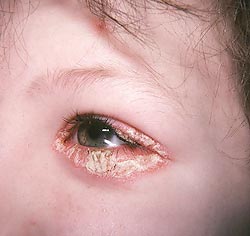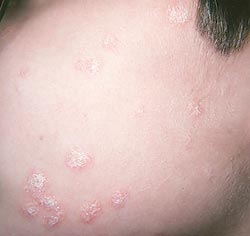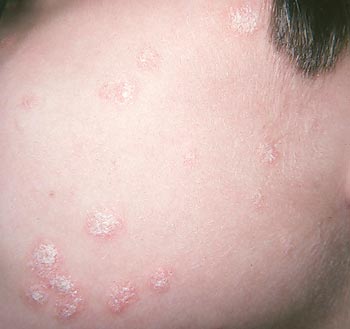A 7-year-old with eyelid dermatitis
This 7-year-old had eyelid dermatitis intermittently for several months.
He will occasionally complain that his eyes are itching. His skin is clear with the exception of an erythematous plaque of the groin area that his mother had not seen until today. He has a negative past medical history and is not on any medications. What do you think is the diagnosis?


Did you manage to spot the rash? Click to the next page to find out.
Answer

This child has psoriasis.
Psoriasis is a chronic skin condition that affects approximately 2% of the population. Approximately 25% of adults with a diagnosis of psoriasis report that they initially had some skin findings of psoriasis prior to age 18. Psoriasis is inherited in an autosomal dominant manner.
The clinical findings of psoriasis are discrete lesions that are erythematous plaques with thick silvery scale (aka psoriatic plaques). The lesions are preferentially located on the elbows, knees, scalp and genital area. In a patient prone to developing psoriasis, trauma can induce new lesions or cause other lesions to form in the pattern of the trauma (Koebner phenomenon). Guttate psoriasis is a variant in which numerous small (guttate from “Gutta,” which is Latin for “tear drop”) plaques erupt on the trunk, extremities and face. This variant occurs more frequently in children than adults and may be triggered by a strep infection or other acute infection. Nail dystrophy is a common finding in psoriasis, particularly pitting of the nails.
Differential diagnoses include contact dermatitis, seborrheic dermatitis, molluscum dermatitis, pityriasis rosea, eczema, and second- ary syphilis.

Treatment options include liberal use of moisturizers (to minimize itching), and avoidance of trauma. Traditional topical treatments in mild psoriasis include: corticosteroids, calcipotriene, tar, and topical retinoids. Secondary bacterial or fungal infections should be treated since the infections themselves can cause a flare of the psoriasis. Anti-pruritics can be useful inselect patients.
Ultraviolet light B and UVA phototherapy (both natural and artificial) can be effective therapeutic options. Systemic therapies for more severe psoriasis include: methotrexate, oral retinoids, cyclosporine, and biologics.
For more information:
- Guilhou JJ, et al: New hypotheses in the genetics of psoriasis and other ‘complex’ diseases. Dermatology 2008;216:87-92.
- Huerta C, et al: Incidence and risk factors for psoriasis in the general population. Arch Dermatol. 2007;143:1559-1565.
- Paller AS, et al: Etanercept treatment for children and adolescents with plaque psoriasis. N Engl J Med. 2008;358:241-251.
Patricia A. Treadwell, MD, is Professor in the Department of Pediatrics, Indiana University School of Medicine, Indianapolis. Spot the Rash is a monthly case study featured in Infectious Diseases in Children designed to test your skills in pediatric dermatology issues.
